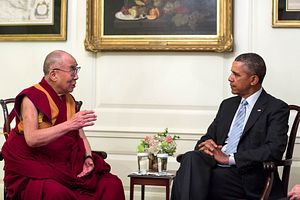On February 21, President Barack Obama met the 14th Dalai Lama in the White House for the third time during his administration. It may not have been in the Oval Office, but the symbolism of the meeting attracted predictable anger from China. The Chinese Ministry of Foreign Affairs took the lead, saying the meeting would “sabotage” and “undermine” relations between the world’s largest and second largest economies.
Outsiders, however, can draw some different conclusions. In brute political terms, it is now clear that of the major powers the U.S. is the final country willing to take the risk of this sort of meeting. The response to British Prime Minister David Cameron’s sit-down with the Dalai Lama in mid-2012 froze relations between the UK and China for a year. Cameron adopted the most conciliatory of tones when finally allowed to visit China in December last year. To the question of whether he would be willing to have another meeting with the Dalai Lama while in power, Cameron simply said it was “not planned.” It is unlikely that he would. The same can be said for all other EU member states. Years of sharp Chinese response and diplomatic backlash have paid off.
The U.S. has the world’s largest military and the largest economy. So it, and it alone, can host such a meeting between the Dalai Lama and the U.S. head of state. Domestically, too, there are dividends for Obama in holding such a meeting. Within the U.S., there is a strong lobby believing that more pressure needs to be put on Beijing, and Tibet is the issue that most merits attention.
Even so, after the drama of the meeting and its fallout have subsided, the stark fact remains that self-immolations are likely to continue. There have already been over a hundred in the Tibet Autonomous Region over the last three years. The political and developmental challenges in the region remain as important and intractable now as they did before Obama met the Dalai Lama. And for a Chinese government looking at the bloodshed and chaos in Kiev, the idea of going soft on this issue gets less appealing by the day.
Tibet is a problem for Beijing, and not for the reasons most outsiders believe. The Chinese government gives little priority to issues of religious and cultural freedom. Their chief headache is that even in their own developmental and economic terms Tibet is failing. Tibet relies on central subsidies for almost all its budget. A superb study by academic Emily Yeh of the region’s economy showed that the vast amount of central money simply ends up going in and out of the region due to the large numbers of non-locals, many from neighboring Sichuan province, who work there short term and send their money back home.
Tibet should be a wealthy province thanks to its natural resources. But these have proved hard to exploit, and the environmental costs of large scale exploitation have so far proved dizzying. The resource-hungry central government looks on the region longing to unlock these potential riches, but they also know that China’s most precious resource of all, water, mostly comes from the Tibetan plateau. The wrong sort of exploitation could well end up making China’s sustainability issues even worse than they currently are.
The Beijing government has no appetite to listen to outsiders lecture them on Tibet. Their response to the Obama meeting with the Dalai Lama was typical. In their book, it was mendacious political meddling, aimed at attacking and destabilizing the Party’s rule. Even so, there is evidently a dearth of ideas about just what to do with Tibet, both in terms of its long term stable governance and its natural condition. The prospect of yet another vast uprising along the lines of that which occurred in early 2008 is horribly possible, especially should the Dalai Lama fall ill or even die. So far, the protests in the region over the last decades have been overwhelmingly peaceful. The Dalai Lama himself has spoken against any use of violence. But more radical voices in the future might jettison this. Then Tibet becomes a very tough issue indeed.
The Beijing authorities need fresh ideas to deal with Tibet, but they have largely closed their minds to some of the most workable ones. Federalism angers them, and they feel the region has all the autonomy it needs, so devolution is unlikely to appeal. They are evidently too risk averse to look at more radical solutions. Their sole strategy now is to place all their chips on economic development and hope that this solves the issue. There is little reason to be over confident in this. If people were satisfied solely by greater material prosperity, then governance across the world would be an easier matter than it evidently is.
Meetings like that between Obama and the Dalai Lama have immense symbolic importance, both for the Tibetan exiles, but also, negatively, for the Beijing authorities. But for all this, the underlying challenges remain unaddressed. The world needs a significantly better quality dialogue with China about these issues, and one less dominated by posturing and political theater. Everyone, both inside and outside China, should be concerned about the stability of the Tibetan region. Things at the moment are not reassuring. We need to have a more open atmosphere for sharing suggestions and ideas. But the modes, and the tone, of debate over Tibet at the moment are mostly divided and defensive. This is a pity, because the issue demands more sustained attention, and the lack of a tolerant and creative debate about the region and its future is a problem not just for Beijing, but for all of us.

































